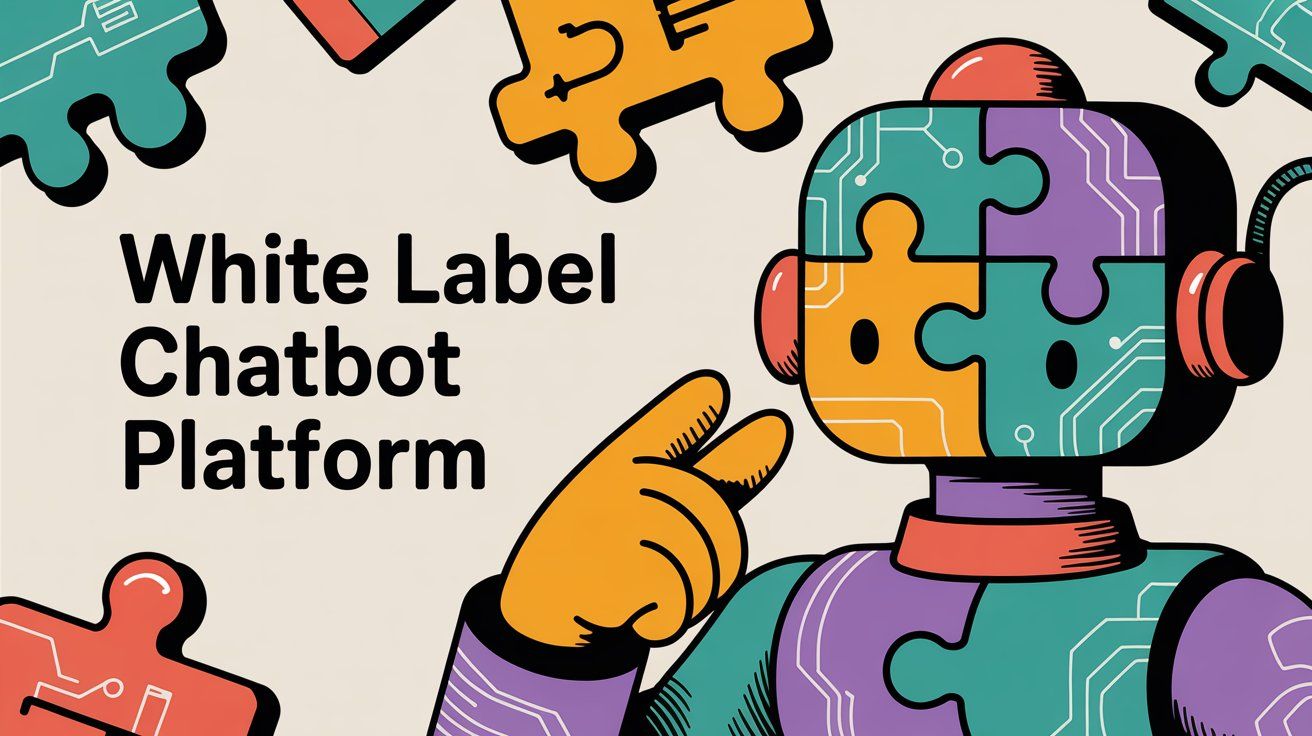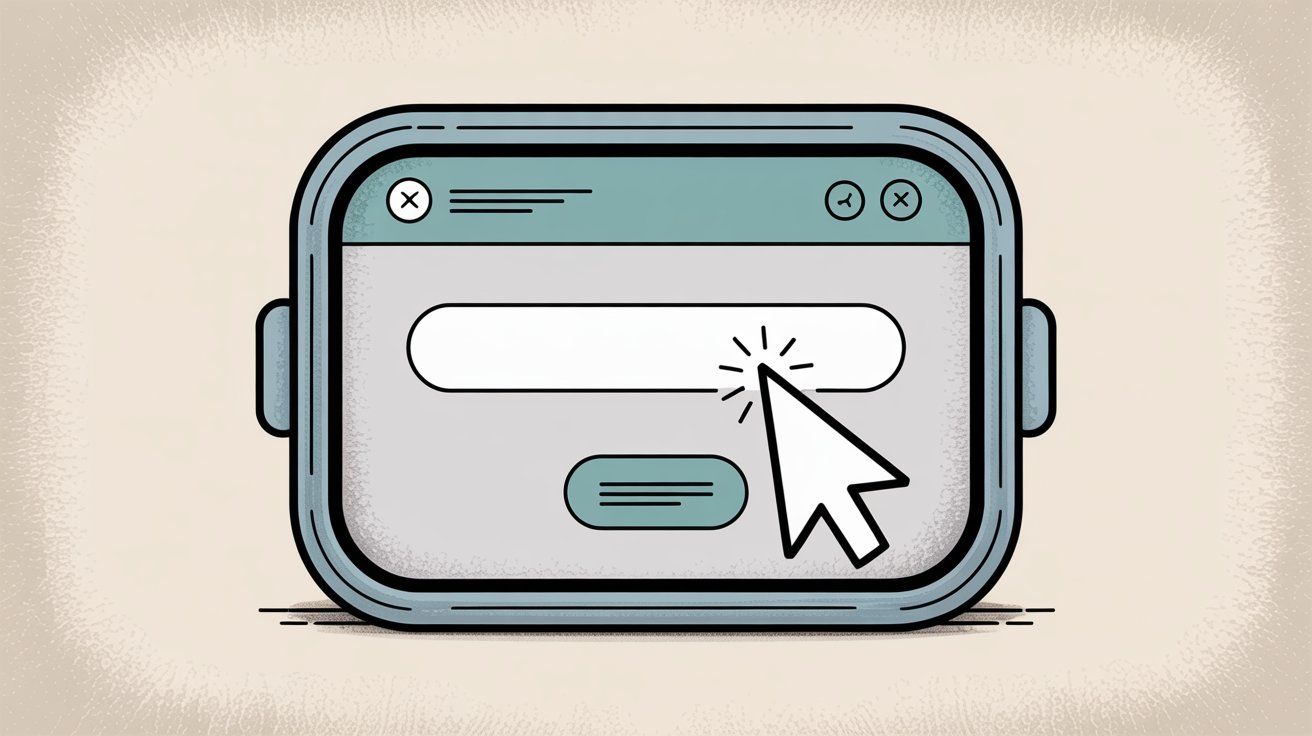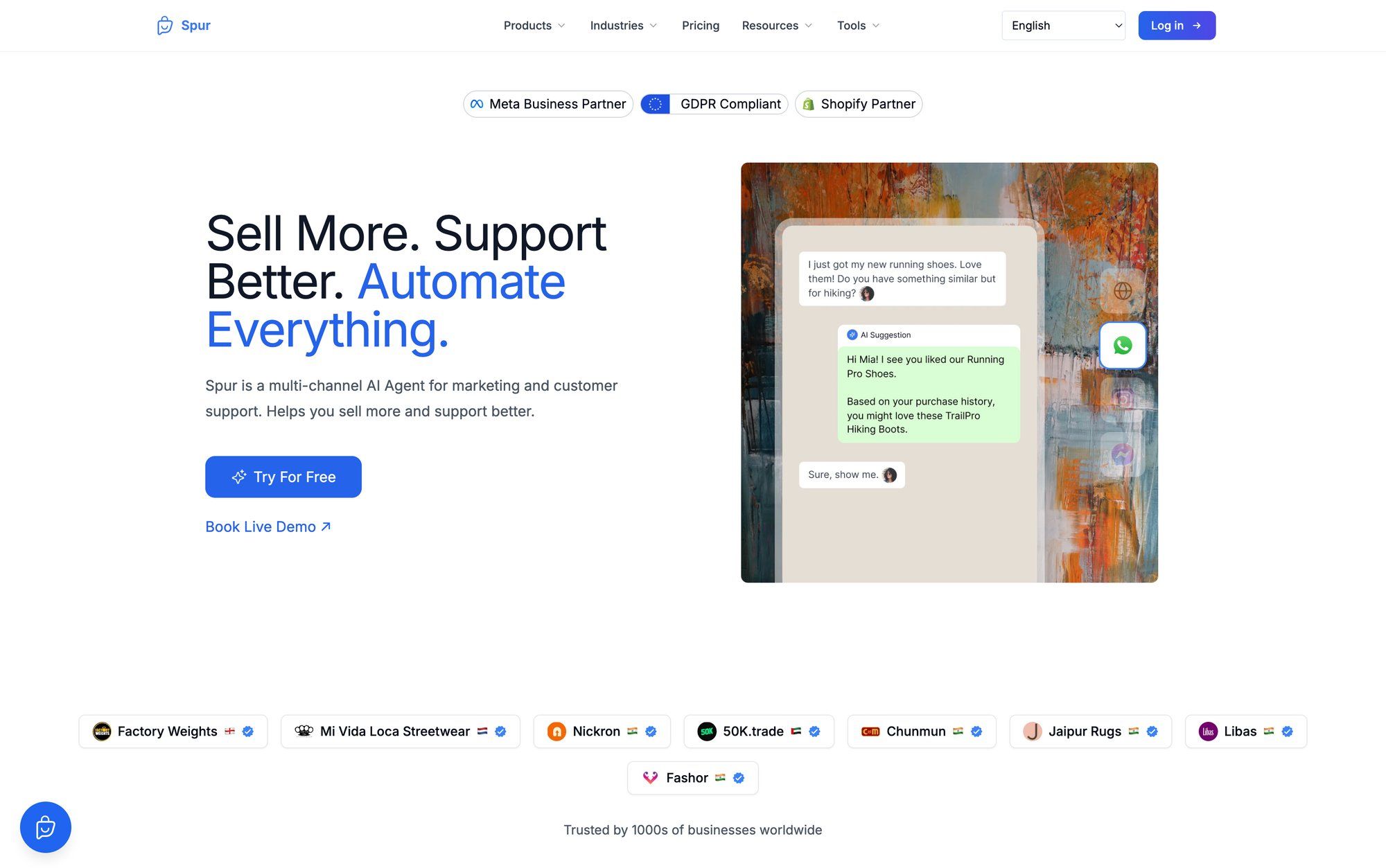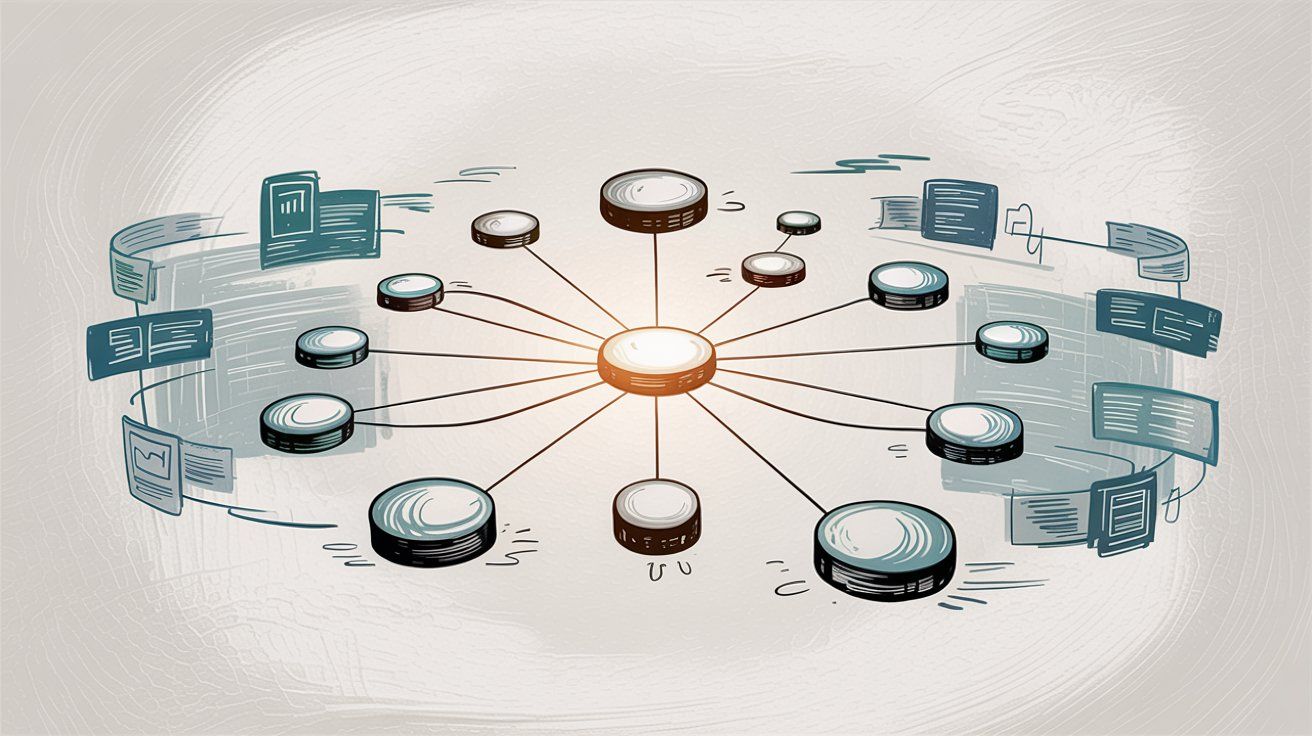
White Label Chatbot Platform: Complete Guide (2025)
Discuss with AI
Get instant insights and ask questions about this topic with AI assistants.
💡 Pro tip: All options include context about this blog post. Feel free to modify the prompt to ask more specific questions!
The chatbot market just crossed $7 billion. Businesses everywhere want AI-powered conversations under their own brand. This guide reveals how white label chatbot platforms let agencies and companies launch sophisticated chatbots without building from scratch. We'll cover what makes a platform truly white-label, key features to demand, and how Spur's Actionable AI approach delivers results that generic Q&A bots can't match.

The AI chatbot boom is here. Businesses know they need automated conversations to handle customer support, capture leads, and scale operations. But most companies don't have the resources to build chatbot technology from scratch. Plus, many don't want another vendor's logo plastered all over their customer-facing tools.
White label chatbot platforms solve this. They let you deploy AI chatbots that look, feel, and operate under your brand. Whether you're an agency building solutions for clients or a business that values brand consistency, white labeling gives you the power of sophisticated AI without the development burden.
A white label chatbot platform lets you rebrand the solution as your own completely. The original vendor's name, logo, and branding disappear. What remains is a chatbot that appears to be your proprietary technology.
Think about it from a customer's perspective. When they interact with the chatbot on your website or WhatsApp channel, they see your company name, your colors, your logo. No "Powered by XYZ" watermark at the bottom. The experience is seamless and professional.
For agencies, this matters. If you're delivering a chatbot solution to a client and it displays someone else's branding, you're advertising a competitor. Your client might wonder why they're paying you when they could go directly to the platform provider.
For businesses, brand consistency matters. A chatbot with random third-party branding breaks the user experience and looks unprofessional. White labeling ensures every touchpoint with your customers reinforces your brand.
The key distinction: A white label platform provides the same powerful functionality (AI conversations, integrations, automation, analytics) but gives you complete control over how it's presented to users.
Building a chatbot platform from scratch is a massive undertaking.
You'd need to:
• Hire AI engineers and developers
• Build conversation flows and NLP capabilities
• Create integration frameworks for different channels
• Handle hosting, security, and compliance
• Maintain and update everything continuously
This easily runs into hundreds of thousands of dollars and takes months or years.
White label platforms bypass all of that. You can launch a fully branded chatbot service in days, sometimes hours. Some platforms claim you can be live in under 12 hours with your own domain and branding.
The chatbot industry is now worth over $7 billion and growing rapidly. By using a white label solution, you enter this market with zero research and development costs. You're leveraging technology that's already been built, tested, and proven.
When you white label, here's what happens:
You focus on:
• Marketing your chatbot services
• Customizing solutions for clients
• Building relationships and closing deals
• Improving conversation flows and customer experience
The platform provider handles:
• Backend infrastructure and servers
• AI model updates and improvements
• Security patches and bug fixes
• Feature development and innovation
• Technical support
This division of labor is powerful. Your team doesn't need deep AI expertise because you're leveraging the provider's specialists. You can allocate all your energy to what drives revenue: selling, deploying, and ensuring client success.
If you're an agency or consultancy, white label chatbots unlock recurring revenue opportunities.
Revenue options include:
• Setup fees for initial chatbot configuration
• Monthly subscription fees for ongoing service
• Per-conversation or usage-based pricing
• Add-on fees for extra channels (WhatsApp, Instagram, etc.)
• Premium features like advanced AI or custom integrations
Because you control the pricing, you can build healthy margins. If a platform costs you $200/month and you can serve 10 clients on it, your cost per client is $20. But you might charge each client $100-150/month, generating significant profit.
Some agencies report that white label chatbots have become a significant driver of revenue raking in millions after adding them to their service lineup. The subscription model creates predictable, recurring income rather than one-off project fees.

Traditional service businesses face a hard constraint: to serve more clients, you need more people. More developers, more support staff, more infrastructure.
White label platforms break this model.
Since the technical infrastructure is handled by the provider, you can add dozens of clients without proportionally increasing your overhead. One agency noted they've been switching to white-label solutions that allow them to scale their offerings without actually increasing their team size.
This is valuable in tight labor markets where hiring skilled developers is expensive and time-consuming.
Most chatbots are glorified FAQ systems. A customer asks a question, the bot searches a knowledge base, and it returns a canned answer. That's helpful for simple queries, but it doesn't deliver real business value.
Spur takes a different approach with Actionable AI

Spur's AI agents don't just answer questions. They take actions that directly impact your business:
• Track orders in real-time by pulling data from your e-commerce system
• Update CRM records when a customer provides new information
• Book appointments by integrating with calendar systems
• Process returns or refunds through connected platforms
• Qualify leads by asking the right questions and routing them appropriately
This is the difference between a static knowledge base bot and an intelligent agent that actually does something.
Instead of a customer asking "Where's my order?" and getting a generic "Check your email for tracking," Spur's AI can instantly query your Shopify store, pull the exact order status, and share the current shipping location. All in one conversation, no human agent needed.
Spur isn't limited to website chat. The platform handles:
• Broadcast messages to large contact lists
• Click-to-WhatsApp ad capture
• Order updates and shipping notifications
• Comment-to-DM automation (move public comments to private conversations)
• Story reaction and mention auto-replies
• Lead qualification through DM flows
• Click-to-Instagram Direct ad optimization
• AI agent trained on your knowledge base
• Seamless handoff to human agents when needed
• Lead capture and contact detail collection
• Custom actions connecting to any backend system
Shared Inbox
• Unified view of all conversations (WhatsApp, Instagram, Facebook, Live Chat)
• Built-in ticketing for human agents
• Context preservation when AI hands off to humans

This omnichannel approach matters because your customers are scattered across platforms. Meeting them where they already are (Instagram DMs, WhatsApp) is far more effective than forcing them to use a website chat widget.
The proof is in the numbers. Spur's case studies show tangible business impact:
• Eves & Gray: Achieved 88.75x ROI in 24 hours with ~99% delivery on WhatsApp carousel messages
• Muffynn: Generated 73x ROI on a targeted broadcast campaign
• Libas: Converted 64 orders from an Instagram Live sale using comment automation (1,000+ viewers, 100+ commenters, ~6% conversion)
These aren't vanity metrics. They're revenue-generating outcomes that businesses actually care about.
One of Spur's critical advantages: you can train the AI on your own knowledge base.
Upload documents, link to your website content, or provide FAQs, and Spur's AI learns from your actual data. This means the chatbot doesn't just rely on generic responses. It understands your products, your policies, and your brand voice.
This is where Spur pulls ahead of competitors. The platform can train on custom knowledge bases, unlike some alternatives that limit AI training capabilities.
The difference is stark. With white label, you partner with experts instead of trying to become the expert overnight in a highly complex, rapidly evolving field.
One comparison noted that white label reselling drastically lowers your risk and up-front investment compared to doing it all yourself. Many agencies are recognizing this and making the switch.
Aspect | White Label Platform | Build Your Own |
|---|---|---|
Time to Market | Days to weeks | 6-12+ months |
Upfront Cost | Low (subscription) | $100,000+ |
Ongoing Maintenance | Provider handles | Your team handles |
AI Updates | Automatic | Manual dev work |
Scalability | Unlimited clients | Limited by infrastructure |
Risk | Low (proven tech) | High (unproven build) |
Not all chatbot platforms allow white labeling. Some popular tools cannot be white-labeled at all. You're stuck with their branding no matter what plan you choose.
When evaluating platforms, here's what separates the real white label solutions from the pretenders:

Essential capabilities:
• Remove ALL vendor branding (no "Powered by..." watermarks)
• Upload your own logo and apply custom colors
• Use your own domain or subdomain for dashboards and chat interfaces
• Brand email notifications and automated messages
• Customize login pages and user-facing interfaces
If a platform only removes branding from the chat widget but keeps it everywhere else, that's not truly white label. You want full control across every touchpoint.
If you're serving multiple clients (standard for agencies), the platform must support:
• Unlimited sub-accounts or workspaces
• Separate data and conversation histories per client
• Admin console to manage all client accounts in one place
• Individual seat/user assignments per client
• Usage tracking and billing per account
Without this, you'll struggle to keep client data separate and organized.
Basic FAQ bots have limited value. Look for:
Integration capabilities:
• Native connections to CRMs (HubSpot, Salesforce, etc.)
• E-commerce platforms (Shopify, WooCommerce)
• Payment processors (Stripe, Razorpay)
• Calendar and booking systems
• Shipping and logistics tools (Shiprocket, Return Prime)
Action triggers:
• Webhook support for custom integrations
• HTTP request capabilities
• API access for external data pulls
• Database connections
• Real-time system updates
Spur's approach here is strong. The platform can integrate with external systems to pull real-time data, update orders, or book meetings automatically. This transforms a chatbot from a simple Q&A tool into a genuine business asset.
AI is powerful, but it's not perfect. There will always be cases where a human needs to step in.
The best platforms provide:
• Automatic transfer to live agents when AI reaches limits
• Context preservation (the agent sees the full conversation history)
• Built-in shared inbox or live chat dashboard
• Agent assignment and routing rules
• Notifications when handoff occurs
Spur handles this elegantly with its shared inbox system. When the AI can't resolve something, it smoothly transfers to a human agent who can continue the conversation in the same thread. The customer doesn't experience any disruption.
Your chatbot should work across the channels your customers actually use:
Core channels:
• Website live chat
• Facebook Messenger
• SMS
• Email (in some cases)
For many businesses, WhatsApp and Instagram are now more important than website chat. Spur specializes in exactly these channels, with official Meta partnerships and deep integration with WhatsApp Business API.
If a platform only supports website chat, you're missing massive opportunities on social messaging platforms.
Modern chatbots need real AI (not just decision trees). Look for:
• GPT-4 or similar LLM integration
• Ability to train on custom data (documents, website scraping, knowledge bases)
• Natural language understanding (not just keyword matching)
• Conversation context awareness
• Ability to handle complex, multi-turn conversations
Spur leverages models like OpenAI, Claude, Gemini, and Grok to power its AI agents. But the critical advantage is the knowledge base training capability, which lets you teach the AI your specific business information.
The interface should be accessible to non-technical users:
• Visual flow builder (drag-and-drop)
• Pre-built templates for common use cases
• Easy conversation design tools
• Quick deployment options
But it should also allow technical customization when needed:
• Custom code blocks
• Webhook configuration
• Advanced logic and conditions
This balance ensures anyone on your team can build basic bots, while developers can create sophisticated custom solutions when required.
To prove ROI and continuously improve, you need data:
Essential metrics:
• Total conversations handled
• Bot containment rate (how many queries resolved without human help)
• Customer satisfaction scores
• Common fallback questions (where the bot struggles)
• Conversion tracking
• Channel-specific performance
Good platforms provide dashboards with these insights or allow you to export data to your own analytics tools.
Understand exactly how the platform charges:
• Per chatbot vs. flat rate
• Per conversation vs. unlimited
• Per user/seat pricing
• Channel-specific costs (WhatsApp conversations often have separate fees)
• Overage charges if you exceed limits
Critical for white label: Can you set your own pricing for clients? Some platforms let you package features into custom tiers with your own price points. Others simply provide the technology and you handle pricing externally.
If a platform costs you $200/month and you can support 10 clients on it, your cost per client is just $20. If you charge each client $100/month, you're generating $1,000 in revenue from a $200 investment. That's a 5x margin.
Make sure the economics work for your business model.
The white label chatbot market has matured significantly. Here are platforms that offer genuine white label capabilities (though features and pricing vary widely):
When evaluating white label options, you'll encounter platforms at different price points and technical sophistication levels. Each serves specific use cases, from agencies wanting affordable entry points to enterprises needing advanced customization.
Important note: Not every popular platform supports white labeling. Some widely used tools do not allow white label branding at any price tier. Always verify this capability before committing to a platform.
While Spur is primarily known as a conversational AI platform for businesses, the architecture and capabilities make it particularly well-suited for agencies and businesses that need branded, multi-channel automation.
1. Actionable AI (Not Just Q&A)
Spur's defining characteristic is that its AI agents can perform actions. They don't just respond to questions. They can:
• Check order status by querying Shopify
• Update customer records in your CRM
• Book appointments through integrated calendars
• Process refunds or returns
• Qualify leads and route them to sales teams
This makes Spur fundamentally more valuable than platforms that only offer knowledge base lookups.
2. WhatsApp + Instagram Specialization
Spur is purpose-built for the channels that matter most in 2025: WhatsApp and Instagram.
• Official Meta Business Partner status
• WhatsApp Business API with broadcasts, drips, and automation
• Instagram comment-to-DM automation (crucial for creator and e-commerce businesses)
• Click-to-WhatsApp and Click-to-Instagram ad optimization
Many chatbot platforms treat these channels as afterthoughts. Spur is designed around them.
3. Knowledge Base Training
Unlike some competitors, Spur lets you train AI on your own knowledge base. Upload documents, connect your website, or provide FAQ databases, and the AI learns your specific business information.
This is critical for delivering accurate, brand-appropriate responses.
4. E-Commerce and D2C Focus
Spur integrates natively with:
• Shopify (with live App Store presence and 4.9/5 rating from 78+ reviews)
• Stripe and Razorpay for payments
• Shiprocket and Return Prime for logistics
If you're serving e-commerce clients or operating a D2C brand, Spur's integrations deliver immediate value with abandoned cart recovery, order updates, and customer support automation.
5. All-in-One Stack (Reduce Tool Sprawl)
Spur combines:
• AI chatbot automation
• Shared inbox for human agents
• Broadcast messaging (WhatsApp marketing campaigns)
• Visual automation builder
• Ticketing system
• Multi-channel support
Instead of stitching together 4-5 different tools, you get one integrated platform. This reduces complexity and cost for agencies managing multiple clients.
6. Proven Results
Spur customers are seeing real ROI:
• 88.75x ROI in 24 hours for Eves & Gray
• 73x ROI on targeted broadcasts for Muffynn
• 64 orders from a single Instagram Live sale for Libas
These results demonstrate that Spur's approach (Actionable AI + multi-channel + e-commerce integration) delivers measurable business outcomes.
Compared to other platforms:
• Some platforms' AI add-ons can't train on custom knowledge bases (Spur can)
• Some platforms don't offer white label branding (Spur does)
• Some platforms lack marketing automation on WhatsApp/Facebook/Instagram (Spur excels here)
• Some platforms don't have built-in knowledge base training systems (Spur does)
• Some platforms are more technical and developer-focused (Spur is user-friendly for non-technical teams)
For agencies serving e-commerce brands, D2C companies, or businesses that rely heavily on Instagram and WhatsApp, Spur offers a more targeted, results-driven solution than generic chatbot builders.
The market is crowded. Here's how to cut through the noise and make the right decision:
Before evaluating features, clarify what you're actually trying to accomplish:
→ Customer support focus?
• Prioritize knowledge base training, human handoff, ticketing systems
• Look for platforms with strong shared inbox capabilities
→ Lead generation focus?
• Prioritize conversation flows, CRM integrations, qualification automation
• Check for native integrations with your lead management tools
→ E-commerce focus?
• Prioritize Shopify/WooCommerce integrations, abandoned cart recovery, order tracking
• Look for WhatsApp and Instagram support (where D2C customers live)
→ Marketing automation focus?
• Prioritize broadcast capabilities, drip campaigns, segmentation
• Check for Click-to-WhatsApp and Click-to-Instagram ad support
Spur is purpose-built for the last two categories (e-commerce and marketing automation), with particularly strong capabilities around WhatsApp and Instagram.
Don't just read feature lists. Actually use the platforms:
During trials:
• Build a simple chatbot from scratch
• Test the conversation flow from a user's perspective
• Check mobile experience (most chatbot interactions happen on mobile)
• Try integrating with one of your existing tools
• Evaluate the admin dashboard usability
If you struggle to accomplish basic tasks during a trial, your team will struggle when it's time to deliver for clients.
Not all "white label" is created equal. Check exactly what can be branded:
Essential questions:
• Can I use a custom domain for the entire admin interface?
• Are email notifications sent from my domain or the vendor's?
• Can I remove ALL vendor logos (widget, dashboard, mobile, emails)?
• What appears in the browser tab title and favicon?
• Are there any "Powered by..." references anywhere?
The best platforms let you white label everything. Lesser ones might only remove branding from the chat widget while leaving it everywhere else.
Run the numbers before committing:
Cost Element | Example Amount |
|---|---|
Cost Side | |
Monthly platform fee | $200/month |
Per-conversation charges | Variable (WhatsApp) |
Add-on costs | Extra channels, users |
Revenue Side | |
Charge per client | $100/month |
Clients supported | 10 clients |
Economics | |
Cost per client | $20 |
Monthly revenue | $1,000 |
Monthly profit | $800 |
Margin | 400% |
Make sure the economics work for your business model. Some platforms charge per chatbot (limiting how many clients you can serve), while others offer unlimited chatbots for a flat rate (better for agencies).
You're betting your client relationships on this platform. Make sure the provider is reliable:
Research questions:
• How long has the company been in business?
• What's their uptime history? (Check status pages)
• How responsive is support? (Test during trial)
• Are they actively developing new features? (Check changelog)
• Do they have case studies or customer testimonials?
Spur, for instance, has been on Shopify's App Store since September 2022, maintains a 4.9/5 rating from 78+ reviews, and is hosting events at Meta's headquarters (Meta HQ Gurugram and Meta Office Mumbai) as an official Meta Business Partner. These are strong stability signals.
Platforms often bury important constraints in the fine print:
Common gotchas:
• Contact or subscriber limits
• Monthly message caps
• Restrictions on certain channels
• Requirements to use their WhatsApp number provisioning (with markup fees)
• Contractual lock-ins (annual commitments)
Read the terms carefully. Ask explicitly about any limits that could affect your business as you scale.
The cheapest platform is rarely the best value. A $50/month tool that can't integrate with your clients' systems or doesn't support WhatsApp will cost you far more in lost opportunities than a $200/month platform with robust capabilities.
Focus on cost per value delivered, not just sticker price.
Many businesses make the mistake of choosing a "website chatbot" platform and then realizing their customers are actually on WhatsApp, Instagram, and Facebook.
If you're serving modern D2C brands, Instagram automation and WhatsApp support aren't nice-to-have features. They're essential.
Spur addresses this directly with purpose-built support for these channels.
Generic AI bots are impressive until they give a customer wrong information about your return policy or product specifications.
The ability to train AI on your specific knowledge base is critical. This is where Spur pulls ahead of platforms that limit AI training capabilities.
AI handles maybe 60-80% of conversations. The other 20-40% need human intervention.
If your platform doesn't support seamless transfer to live agents (with conversation context preserved), you're creating a terrible customer experience. Spur's shared inbox solves this elegantly.
What works for 3 clients might break at 30 clients.
Choose a platform that can handle your growth without requiring a migration in 12 months. Look for unlimited or high client account limits, usage that scales gracefully, and pricing that doesn't explode as you add customers.
When you implement a white label chatbot platform correctly, here's what changes:
You can:
• Offer a new recurring revenue service without hiring developers
• Serve more clients without proportionally expanding your team
• Differentiate from competitors who don't have chatbot capabilities
• Create predictable monthly income (vs. one-off project fees)
• Upsell existing clients on automation services
Your clients get:
• Professional AI chatbot solutions without seven-figure budgets
• Faster response times and better customer satisfaction
• Measurable ROI through automated support and lead capture
• Brand consistency (everything looks like their company)
You achieve:
• 24/7 customer support without hiring night shift agents
• Automated lead qualification and routing
• Reduced support ticket volume (AI handles repetitive questions)
• Better conversion rates (instant responses on WhatsApp and Instagram)
• Data and insights on customer questions and behavior
Your customers experience:
• Instant answers to common questions
• Seamless transitions to human agents when needed
• Consistent service across all channels
• Convenient interactions on their preferred platforms
Spur customers demonstrate this in practice. Eves & Gray achieved 88.75x ROI in 24 hours through WhatsApp automation. Libas converted 64 orders from a single Instagram Live using comment automation. These are real business outcomes, not vanity metrics.
When you white label a chatbot platform, you're often seen as the data controller by your clients. This means you need to be confident in the underlying platform's security.
Data privacy:
• Is the platform GDPR compliant?
• Where is data stored (data residency)?
• Can you sign a Data Processing Addendum (DPA)?
• What happens to data if you cancel service?
Security:
• Does the platform have SOC2 or ISO certifications?
• How is data encrypted in transit and at rest?
• What's the incident response process?
• Are there role-based access controls?
Spur, for example, hosts servers in Frankfurt, Germany and sets WhatsApp data localization to Europe for GDPR compliance. Spur publishes a DPA with Standard Contractual Clauses.
These details matter. A data breach under your branded solution would reflect on your reputation, not just the platform provider's.
The best chatbot is one that connects to the rest of your tech stack.
Critical integrations to verify:
E-commerce:
• Shopify, WooCommerce, or other platforms your clients use
• Can the bot pull order data? Track shipments? Handle returns?
CRM:
• HubSpot, Salesforce, Pipedrive
• Can the bot create/update contact records?
Payment:
• Can the bot process transactions or check payment status?
Marketing:
• Email platforms (Mailchimp, Klaviyo)
• Can the bot add contacts to marketing lists?
Calendar:
• Google Calendar, Calendly
• Can the bot book appointments?
Spur's integration portfolio covers the D2C and e-commerce stack comprehensively: Shopify, WooCommerce, Stripe, Razorpay, Shiprocket, Return Prime, plus WhatsApp, Instagram, Facebook, and Live Chat channels.
If a platform lacks the integrations your clients need, you'll spend countless hours building custom middleware or workarounds. Choose wisely.

The math that makes white label chatbots attractive:
Approach | Traditional Build | White Label |
|---|---|---|
Year 1 Investment | $150,000+ (dev team) | $200-500 (subscription) |
Ongoing Costs | $10,000/month | $200-500/month |
Time to First Client | 6-12 months | 1-2 weeks |
Risk Level | High (unproven tech) | Low (proven platform) |
Revenue scenario:
You land 10 clients at $150/month each.
① Monthly revenue: $1,500
② Platform cost: $300
③ Profit: $1,200/month ($14,400/year)
④ Margin: 80%
As you add clients (20, 50, 100), your platform cost stays relatively flat while revenue scales linearly. This is the magic of the white label model.
One platform provider shared a case study where a CPaaS company added their white label chatbot offering and it has now become a significant driver of revenue raking in millions while the provider handled all the technical heavy lifting.
The AI landscape is evolving rapidly. Your platform choice should position you for the future, not just today's needs.
Innovation velocity:
• How often does the platform release new features?
• Are they keeping pace with AI model improvements (GPT-4, Claude, etc.)?
• Do they have a public roadmap?
Channel expansion:
• If new messaging platforms emerge, will they support them?
• Can they add new integrations relatively quickly?
AI advancement:
• As models improve, will those improvements flow to your chatbots automatically?
• Can you switch AI models if a better one becomes available?
Platforms with active development teams and strong funding are more likely to stay competitive. Spur, as an official Meta Business Partner hosting events at Meta headquarters, demonstrates the kind of strategic partnerships that signal long-term platform viability.
You've evaluated platforms, run the numbers, and tested features. Here's how to make the final call:
Rate each platform (1-10) on factors that matter to your business:
• Ease of use
• White label depth
• Channel support (WhatsApp, Instagram, etc.)
• AI capabilities and knowledge training
• Integration ecosystem
• Pricing and margins
• Support quality
• Brand reputation
• Scalability
Weight the factors based on importance. If you're primarily serving e-commerce clients, integration with Shopify and WhatsApp support might be weighted 2x.
Before committing fully, run a small pilot:
• Choose 1-2 internal or friendly clients
• Deploy the platform with full branding
• Monitor performance for 30-60 days
• Gather feedback from users and your team
• Measure actual outcomes (support tickets deflected, leads captured, etc.)
This real-world testing reveals issues that trials can't.
Once you've chosen a platform, map out how you'll bring it to market:
Positioning:
• What's your unique angle? (Industry specialization? Integration expertise?)
• How do you differentiate from other agencies offering chatbots?
Pricing:
• What tiers will you offer?
• What's included at each level?
• How does pricing scale with usage?
Sales enablement:
• What case studies can you create?
• Do you need demo environments?
• What's the sales process (discovery, demo, pilot, launch)?
Delivery:
• Who handles initial setup?
• What's the onboarding process for new clients?
• How do you train clients to use the system?
Some clients worry that chatbots feel impersonal or will frustrate customers.
Solution:
• Emphasize the human handoff capability. AI handles simple queries, humans handle complex ones.
• Share case studies with ROI metrics (like Spur's 73x-88x ROI examples)
• Start with a limited pilot (one channel or use case) to prove value before full deployment
Getting AI to answer accurately requires feeding it good information.
Solution:
• Use platforms like Spur that can scrape websites for training data automatically
• Start with FAQ documents the client already has
• Implement iterative training: launch with basics, improve over time based on real conversations
• Monitor fallback questions to identify gaps in the knowledge base
Connecting the chatbot to existing systems (CRM, e-commerce, etc.) can be technical.
Solution:
• Choose platforms with native integrations for tools your clients use
• For custom needs, use Zapier or Make to bridge gaps without custom code
• Look for platforms with good API documentation if you need to build custom connections
• Consider hiring a specialist for the first integration, then replicate for future clients
Juggling 10+ client chatbots gets complex quickly.
Solution:
• Use platforms with multi-tenant architecture that separate client data automatically
• Implement naming conventions for accounts, flows, and configurations
• Create templates for common chatbot types (e-commerce support, lead gen, etc.)
• Build SOPs for setup, training, and maintenance
What's the difference between white label and regular chatbot platforms?
White label platforms let you completely rebrand the solution as your own, removing all vendor branding and using your logo, colors, and domain. Regular platforms keep the vendor's branding visible to end-users. For agencies and businesses that value brand consistency, white labeling is essential.
Can small agencies afford white label chatbot platforms?
Yes. Some platforms offer white label capabilities at price points accessible to small agencies. The key is ensuring the economics work: if you can support 5-10 clients on one subscription and charge each $100-150/month, you'll generate solid margins even with modest client counts.
How long does it take to launch a white label chatbot service?
With the right platform, you can be live in 1-2 weeks. Some providers claim 12-hour launches. The timeline depends on: setting up your branded domain, configuring initial chatbot templates, creating sales materials, and securing your first client. The actual technical setup is usually the fastest part.
Do I need technical skills to use white label chatbot platforms?
Most modern platforms are no-code or low-code, meaning non-technical users can build chatbots using visual builders and templates. However, having some technical capability on your team helps with integrations, custom API calls, and troubleshooting. Spur is designed to be user-friendly for non-technical teams while still offering advanced capabilities for those who need them.
What channels should my white label chatbot support?
At minimum: website live chat and WhatsApp. For many businesses in 2025, Instagram DMs are equally important. Spur specializes in WhatsApp Business API and Instagram automation, which are increasingly where D2C brands engage customers. Facebook Messenger and SMS are valuable add-ons depending on your target market.
How do I price white label chatbot services to clients?
Common models include: setup fees ($500-2,500) plus monthly subscriptions ($100-500/month per client). Some agencies charge per conversation or per channel. The key is ensuring your pricing covers the platform cost plus provides healthy margins. If your platform costs $300/month and supports 10 clients, you need to charge at least $30/client to break even, but $100-150/client is more realistic for profitability.
What's "Actionable AI" and why does it matter?
Actionable AI refers to chatbots that can perform actions in external systems, not just answer questions. For example, Spur's AI can check order status in Shopify, book appointments in calendars, update CRM records, or process refunds. This is far more valuable than simple FAQ bots because it actually resolves customer needs end-to-end without human intervention.
Can white label chatbots integrate with my existing tech stack?
Most quality platforms offer integrations with popular tools. Spur, for instance, integrates natively with Shopify, WooCommerce, Stripe, Razorpay, Shiprocket, Return Prime, and various messaging channels. For tools without native integrations, many platforms support webhooks or API connections that let you build custom integrations. Always verify that critical integrations are available before committing to a platform.
What happens if I want to switch white label platforms later?
Switching is possible but can be painful. You'll need to rebuild chatbot flows, retrain AI on the new platform, reconfigure integrations, and possibly migrate conversation data. This is why choosing the right platform upfront is so important. Look for platforms with data export capabilities and avoid those with heavy lock-in. Most white label agreements are month-to-month, so you're not contractually locked in, but the operational switching cost is real.
How do I ensure my white label chatbot complies with GDPR and data privacy laws?
Choose platforms that are GDPR-compliant and offer Data Processing Addendums (DPAs). Check where data is stored (EU data residency helps with GDPR). Spur hosts servers in Frankfurt, Germany and sets WhatsApp data localization to Europe for GDPR compliance. Also ensure the platform has proper security certifications (SOC2, ISO) and that you understand data retention policies. Since you're white-labeling, you may be seen as the data controller, so the platform's compliance becomes your compliance.
What ROI can clients expect from chatbot automation?
ROI varies widely based on use case, but Spur customers have achieved impressive results: 73x-88x ROI on WhatsApp campaigns, 64 orders from a single Instagram Live event, and significant reductions in support ticket volume. For e-commerce, abandoned cart recovery alone can generate 10-30x ROI. For support use cases, if a chatbot handles 500 tickets/month that would have taken 10 minutes each, that's 83 hours saved (roughly 2 full-time support agents).
Can I customize the AI's personality and tone?
Yes, quality platforms let you train the AI on your knowledge base and often allow tone/personality configuration. With Spur, you can upload your brand guidelines, sample conversations, and knowledge base documents to teach the AI your specific voice and information. This ensures the chatbot sounds like your brand, not a generic robot.
The opportunity is clear. The AI chatbot market has crossed $7 billion and continues growing rapidly. Businesses need automated conversations across WhatsApp, Instagram, websites, and more. They want solutions that work under their brand and integrate with their existing systems.
White label chatbot platforms let you deliver exactly that without building technology from scratch.
Whether you're an agency looking to add a new revenue stream, a SaaS company wanting to embed chatbot functionality, or a business that simply values brand consistency, the white label model offers speed, scalability, and profitability that building in-house can't match.
Your next steps:
① Clarify your use case: Support? Lead gen? E-commerce? Marketing automation?
② Evaluate 2-3 platforms that match your needs (use the feature checklist in this guide)
③ Run hands-on trials to test usability, integrations, and white label depth
④ Calculate the economics to ensure profitable pricing
⑤ Start with a pilot (1-2 clients) before scaling
If your focus is on e-commerce, D2C brands, and WhatsApp/Instagram automation, Spur deserves serious consideration. The combination of Actionable AI (real actions, not just Q&A), knowledge base training, multi-channel support, and proven ROI makes it particularly strong for these use cases.
Ready to see what Actionable AI can do for your business or clients? Explore Spur's platform and discover how automated conversations can drive measurable results across WhatsApp, Instagram, and live chat.
The white label chatbot opportunity is here. The only question is whether you'll capitalize on it with proven technology or try to build it yourself from scratch.
